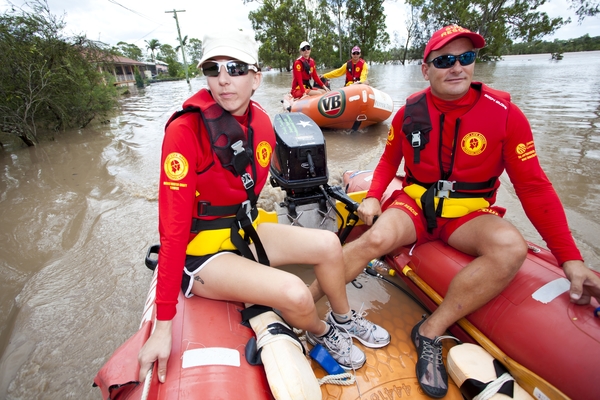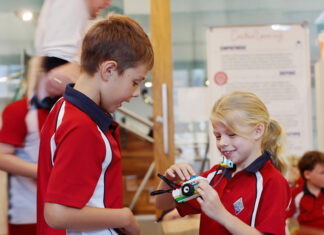
By RON LANE
The summer is over and for the majority of the volunteer lifesaver it is now football, tennis or just plain surfing – no more rostered patrols. The winter months are leisure time.
However, for a small elite team of volunteer lifesavers known as the Emergency Response Group, it is never over.
This is the team that responds to the special jobs in remote areas, out-of-the-way places and, in particular, the toughest job of all – the night-time call out, even in winter.
It is hard to believe but it happens all the time, even in the cold months of winter and the dead of night. Some people just don’t stop and think.
And here is a common scenario.
The family has just arrived from down south and, despite the fact it has turned dark and getting chilly, a quick swim at the beach in front of their resort is the thing to do.
Their pride and joy, 10-year-old son and 12-year-old daughter, have each received a boogie board as a winter vocation present.
Not strong swimmers, they have just joined swim classes at school but, no worries, they will be OK.
Arriving at their area of choice they run to the water’s edge and on this cold moonlight night they can just make out a sand bank 20 metres out. No winter wet suits. Paddle out, ride the boogie board to shore. Easy. Then quickly home to a hot shower.
They go and suddenly they are out of sight. Then minutes later the two boards hit the water’s edge.
No kids, a laugh then silence, then all of a sudden a scream. Dad swims out, then nothing. Back on the beach a small crowd has gathers and someone has a mobile.
Then a calm voice, “I’ll call triple zero”.
He asks for police, tells them they are 400 metres south of the Sunshine Beach Surf Club and two children and an adult have disappeared out back of a sand bank roughly 20 to 30 metres out.
The police tell the caller to stay where he is and, in the meantime, mum has grabbed a torch that was supposed to show the kids their way back to their lodge. She turns it on to use as a beacon.
Then in the cold winter’s night in the deafening silence – they wait.
At the police base they have a phone roster which lists after hours numbers for such emergencies.
As each surf club has members who are in the Emergency Response Group, their mobile numbers are listed.
Despite the fact that it is winter and the family evening meal is now under way, a volunteer lifesaver takes the call, leaves the family table and goes.
However, this time there is an addition to his call-out kit. It’s winter so the heavy duty wet suit is added.
The wheels are in motion. All team members assemble, everything is double checked and the boat is launched.
In no time in the dead of night a search pattern is under way and, luckily this time, all ends well. But next time, who knows?
Be it 8pm or 2am, good weather or pouring rain in mid-winter, these people respond when called on because, as members of the Emergency Response Group, part of their job, even in the dead of winter, is to “cover the night”.
These are teams of highly trained people on 24-hour callout and, as such, they have created a reputation for themselves as being dedicated. Dedicated with a tough and professional attitude.
Their work when called to assist in the catastrophe Brisbane floods and also the Tewantin floods of recent years was second to none.
The clubs at the northern end of the Sunshine Coast work together covering an area that stretches virtually from the Wilderness Camp on North Shore to Peregian. Summer and winter, daytime and night, they are always on call.
“It is now 20 years since this Emergency Response Group was formed. As this group also does so much night work it has achieved a record of which we can be proud,” said Dave McLain, State Coordination Officer.
Worthy of note is that, for example, on a call out from Noosa to the A Bay region, these IRB teams of the Emergency Response Group are, as a result of their high standard of training and state-of-the-art equipment, capable of a response time of eight to 10 minutes, depending on conditions.
Because of the night work and other aspects, the crewies usually join the group at about the age of 24.
“By this age they have moved into a more mature age bracket that we feel is more suited to our type of operations,” said a senior spokesman.
It therefore comes as no surprise to know that over the years many of these people have been recipients of the Special Surf Life Saving Excellence Awards for outstanding dedication and devotion to duty.
From the Sunshine Beach Club there are men such as Bill Twigger, Warick Redwood, Craig Law, Scott Summers and the lady of the team, Jane Fraser.
The Noosa members of the team are father and son Chris and Keaton Grandemange, Joe Cirillo, Ian Widdicombe, Chris Vaughan and Roger Aspinall.
For Bill Twigger and Warick Redwood the night work commenced some 10 years ago and during this time the Jet Rescue Boat was still stationed at Noosa.
Several members from both clubs, now retired from the service, experimented with the problem of lights for the night callouts.
“In those early days lights were provided by high powered torches tied to the side of the boats,” Bill said with a laugh.
“But the problem was finally resolved and now all is OK.”
To establish a top class tourist resort and hold a five-star rating in all aspects, nothing can be left to chance.
With the massive increase in visitors to beach areas the role of both the volunteer lifesavers and the paid lifeguards is a vital and necessary part of the tourist industry.
As a result, all aspects of surf lifesaving are under heavy scrutiny and are constantly being reviewed.
Consequently, the training for the Emergency Response Group is never ending.
Therefore it is only right that we acknowledge these lifesavers for they are indeed Our People.






